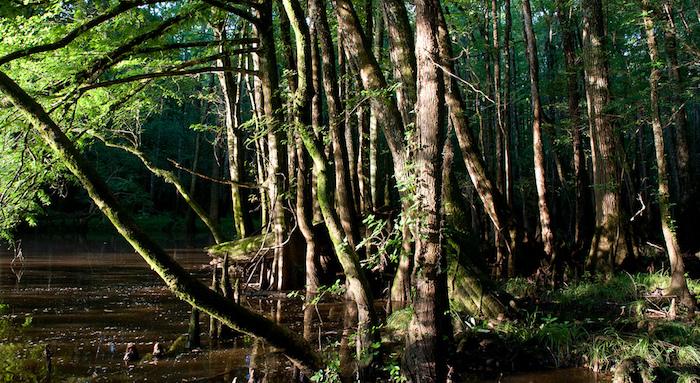
Boardwalks help you meander through Congaree without getting your feet wet/Harold Jerrell
The absence of human sounds was mesmerizing. Insects buzzed, and birds sang, their sounds rising and falling as they drew near and flew off. One sound we didn't hear was the tell-tale drumming on tree bark of Ivory-billed woodpeckers, though some think the birds thought extinct might exist deep within Congaree National Park in South Carolina.
Is the species still breeding in Congaree? Some like to think, or rather hope, they do. After all, the habitat is there in the form of the largest intact expanse of old growth bottomland hardwood forest remaining in the southeastern United States. And what a wildlife story it would be if one was positively sighted in the park!
But there's more to Congaree than wishful thoughts of a majestic, and increasingly mythic, bird. Covering more than 26,000 acres just down the road from Columbia, South Carolina, the park was designated a Biosphere Reserve by the United Nations Educational, Scientific, and Cultural Organization in 1983 because of that old growth bottomland hardwood forest, which the National Park Service describes on the park's website:
Waters from the adjacent Congaree and Wateree Rivers periodically sweep through the Park’s floodplain, carrying nutrients and sediments that nourish and rejuvenate this unique ecosystem. Forested wetlands, oxbow lakes, slow moving creeks and sloughs provide ample habitat for fish, birds, amphibians, reptiles, mammals, insects and other aquatic life. A variety of forest communities are also represented across the landscape, with dominant tree species ranging from upland pines along the elevated bluffs to bottomland species such as bald cypress and water tupelo within the floodplain.

Some of the park's bottomlands/NPS
The bottomlands of the Congaree Swamp, which look pretty much the way they did when Native Americans hunted there, are mantled with bald cypress, tupelo, laurel oak, sweet gum, water hickory, loblolly pine, and other trees inclined to grow to unusually large size. Thanks to periodic flooding (averaging 3 significant floods a year, with a major one about every three years) and the deep fertility of the muck, peat, and related alluvial soils, the Congaree Swamp has one of the tallest temperate forest canopies in the world. There are at least 20 state or national champion trees and lots of others nearly as big. Small wonder that some admirers were inspired to dub this place “Redwoods East.”
Few places this size can match Congaree for ecological diversity. People used to seeing managed monoculture forests with even-aged stands of trees are blown away when they see the variety of plant and animal life in this place. In addition to 75 or so species of trees, the park has at least 195 species of birds, 60 species of fish, more than 65 species of butterflies, hundreds of insect species, and more than 75 species of reptiles and amphibians.
Congaree actually has four different kinds of forests, including a mixed pine and upland forest found on the higher ground of the bluffs and three kinds of wetlands -- mixed bottomland hardwoods, swamp tupelo seepage, and cypress-water tupelo swamp. The latter is highly distinctive because the bald cypress and tupelo grow in the standing or slowly flowing water of sloughs, guts, and ponds.
There are various ways to explore the park. A boardwalk rambles through part of Congaree, while canoeists and kayakers can explore the watery veins that meander through the heart of the park. Rangers often lead canoe tours when conditions permit.
Exploring miles of boardwalk and a dense canopy of old growth hardwood trees might be what many visitors remember about Congaree National Park. But about ten times a year the waters from the Conagree and Wateree rivers sweep through the floodplain wilderness, opening up a whole new surreal world for paddlers and an opportunity to discover the forest from a unique perspective. You can kayak through the woods and experience this special place through the eyes of local veterans Eric Guzman and Edye Joyner.

Paddling is a popular way to explore Congaree National Park/NPS
And while the Ivory-billed woodpecker might not be a resident, there are countless other birds to go in search of with binoculars and spotting scopes.
Though the park might seem to be surrounded by humanity, you do have to be careful about wandering off and getting lost in Congaree. That happened back in 2014 when a father and his two children wandered about two miles off a trail and couldn't find their way back.
Campers will find a good measure of solitude in the park, as car camping (and its occasional generators) is no longer allowed at the park. There are two campgrounds, Longleaf and Bluff, and the latter requires a hike of about a mile to reach. Longleaf Campground is located adjacent to the park entrance road. These are rustic campgrounds, with no running water and no restrooms at Bluff Campground (Longleaf has vault toilets).
Experienced paddlers can head into the park's via Cedar Creek for Wilderness for camping. Backpackers have a small number of trails they can head down for overnighters.
Sadly, a sign of humankind's footprint in the park can be found in traces of pharmaceuticals, pesticides, and chemicals turned up in a sampling of water deep within Congaree. Though the concentrations of the pollutants -- 49 pharmaceuticals and 47 other contaminants -- were not considered high enough to pose a risk to park visitors who might drink water in the backcountry, they point to problems with area runoff and, possibly, backcountry travelers.
Traveler's choice for: Birding, botany, solitude, short paddles.





